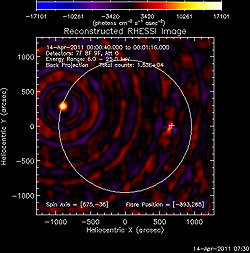National Aeronautics and Space Administration
Goddard Space Flight Center

Space Weather Action Center
Storm Signals
Tutorial: RHESSI Images
The RHESSI satellite uses an instrument that can produce images of high-energy X-ray and gamma-ray emissions. A software algorithm automatically identifies events in the RHESSI data, and these events include solar flares as well as other events that may be of scientific interest. For the solar flares, other software automatically generates images in a number of energy bands, and these images are called "quicklook" images.
These quicklook images provide a very useful tool for easily checking that an event seen in the RHESSI light curves is a solar flare and determining from where it originated on the Sun. The location of the flare is typically associated with a group of sunspots, or active region, on the Sun. A given active region can be visible for two weeks as the Sun rotates, and can produce many flares during that time.
Navigation

Above: the RHESSI Images date chooser
The RHESSI browser opens at an automatically selected time, which may not correspond to the most recent data available. You can start by selecting the day you are interested in:
- Select the appropriate year
- Select the appropriate month (some months are not listed if there are no RHESSI data)
- Select the appropriate day (some days are not listed if there are no RHESSI data)
Above: the RHESSI Images 24 hour time bar
Because flares can be as short as a minute, you will need to select a particular flare on that day before you can see any images. There are two ways for selecting a flare:
- If you know when the flare occurred, you can click on the 24-hour time bar to pick the appropriate time-of-day (in Universal Time, or UT).
- If you want to see all the flares observed by RHESSI on the currently selected day, you can open the drop-down list labeled by "Flare #". This list contains all the events (listed by number) that have been identified by an automatic algorithm, and the events without a trailing "-" are flares and should have corresponding images. Note that there may be days without any flares, especially if solar activity is low. Select one of the flares.
Example
- Select "2002" for the year
- Select "Jul" for the month
- Select "23" for the day
- Select "01" from the drop-down list labeled "Flare #"

Above: A reconstructed RHESSI Image from the data page
Interpretation
The colored bar across the top indicates the intensity scale of the X-ray or gamma-ray emission in the image, with the strongest emission being yellow to white. The coordinate system is centered on the Sun, and the axes measure the angle on the sky in units of arcseconds (1 arcsecond is 1/3600 of a degree). The edge of Sun, or limb, is denoted by the white circle, and thus solar flares will occur within or just slightly outside this circle. Also listed on the image is relevant technical information such as the time range (in UT) and the energy band (in keV).
The solar flare itself will appear as the brightest spot in the image. Due to RHESSI's imaging method, there will also be red and purple concentric rings encircling the flare. If the location of the flare is very close to the location of the so-called "spin axis" of the spacecraft (denoted by a white cross), then the image may be somewhat distorted.
Advanced
This full-Sun image is useful for seeing where the flare occurred in the context of the whole Sun, but it only shows the image for the energies 6-25 keV. If you click the magnifying glass to the right of "Quicklook Images" in the upper left, you will reveal a list of checkboxes that let you turn on the display of images for a variety of energy bands. Note that these types of images are zoomed in, so you may or may not see the white circle representing the solar limb.
You are viewing a tutorial
Related Tutorials
The above tutorials compliment the downloadable Flip Charts and Data Sheets.
